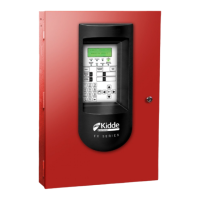Chapter 2: Front panel programming
P/N 3102352-EN • REV 005 • ISS 28DEC18 53
Description
Smoke verified + CO
supervisory latching
For smoke + CO detectors that trigger an alarm verify event first, and then trigger
an active alarm event only after confirming the alarm condition (smoke) or trigger
a supervisory latching event (CO). [1]
Smoke verified + CO
supervisory nonlatching
For smoke + CO detectors that trigger an alarm verify event first, and then trigger
an active alarm event only after confirming the alarm condition (smo
a supervisory nonlatching event (CO). [1]
Smoke verified + CO monitor
latching
For smoke + CO detectors that trigger an alarm verify event first, and then trigger
an active alarm event only after confirming the alarm condition (smoke) or tr
a monitor latching event (CO). [1]
Smoke verified + CO monitor
nonlatching
For smoke + CO detectors that trigger an alarm verify event first, and then trigger
an active alarm event only after confirming the alarm condition (smoke) or trigger
a monitor nonlatching event (CO). [1]
[1] Supports Standalone mode of operation.
Note: Available device types depend on the position of the slide switch on the front of the module. For example, if
the slide switch is in the alarm position, only alarm device types are available.
Table 13: Input module device types
Description
Allows for the monitoring of two-wire conventional smoke detectors in a
Class A circuit (that do not require alarm verification) and normally open
contact initiating devices on the same circuit. [1]
Allows for the monitoring of two-wire conventional smoke detectors in a
Class B circuit (that do not require alarm verification) and normally open
contact initiating devices on the same circuit. [1]
Allows for the monitoring of two-wire conventional smoke detectors in a
Class A circuit (that require alarm verification). [1]
Class B Allows for the monitoring of two-wire conventional smoke detectors in a
Class B circuit (that require alarm verification). [1]
For smoke detectors and contact devices. All activations are immediately
considered as alarms. Circuit cannot be r
estored until devices are restored to
normal and the panel is reset. [1]
For duct smoke detectors. All activations are immediately considered as
alarms. Circuit cannot be restored until devices are restored to normal and
the panel is reset. [1]
For heat detectors and contact devices. All activations are immediately
considered as alarms. Circuit cannot be restored until devices are restored to
normal and the panel is reset. [1]
For pull station devices. All activations are immediately considered as
alarms. [1]
For a remote switch that when activated, starts the panel’s drill operation.
For a remote switch that when activated, resets the panel.

